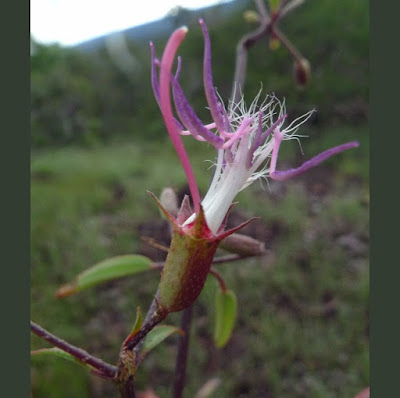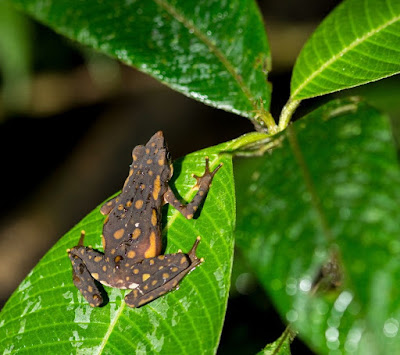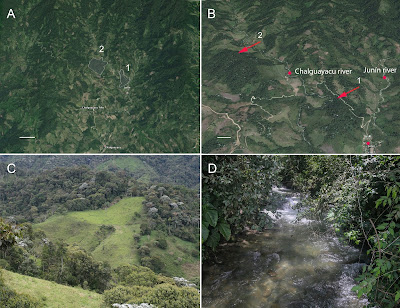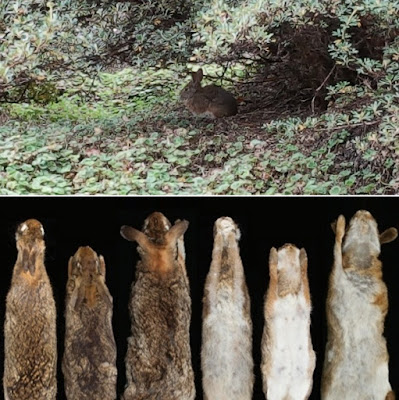[Most Recent Entries] [Calendar View]
Thursday, June 1st, 2017
| Time | Event | ||||
| 7:42a | [Botany • 2016] Tibouchina rosanae • A New and Unusual Amphistomatic Species of Tibouchina (Melastomeae, Melastomataceae) from Brazil
Abstract Tibouchina rosanae, a new species of Melastomataceae (Melastomeae) from the state of Mato Grosso, Brazil, is described, illustrated and compared to its putative closest allied. It is characterized mainly by the inflorescence that is lax. Tibouchina rosanae is an amphistomatic species, and the presence of stomata on the adaxial leaf surface is reported here for the first time in the genus. Keywords: Mato Grosso, Xingu State Park, Eudicots, Brazil Tibouchina rosanae P. J. F. Guim. & Woodgyer, sp. nov. Etymology:— This species is dedicated to Dr. Rosana Romero, in recognition of her contributions to the taxonomy of Neotropical Melastomataceae, particularly in tribe Microlicieae, and her skilled ability to supervise new students in the study of this botanical family. Distribution and Habitat:— Tibouchina rosanae is recorded for ca. 290 m elevation, growing in patches of Amazon grassland vegetation on sandstone rocks (campos rupestres) in Xingu State Park, in the municipality of Santa Cruz do Xingu, Mato Grosso state, Brazil. Paulo José Fernandes Guimarães and Elizabeth M. Woodgyer. 2016. A New and Unusual Amphistomatic Species of Tibouchina (Melastomeae, Melastomataceae) from Brazil. Phytotaxa. 246(2); 145 - 151. DOI: 10.11646/phytotaxa.246.2.6 | ||||
| 8:25a | [Herpetology • 2017] Rediscovery of the Nearly Extinct Longnose Harlequin Frog Atelopus longirostris (Bufonidae) in Junín, Imbabura, Ecuador
Abstract We report the recent finding of four adults of Atelopus longirostris, a Critically Endangered species that was last seen in 1989, when catastrophic Atelopus declines occurred. The rediscovery of A. longirostris took place in a new locality, Junín, 1250–1480 m asl, Provincia Imbabura, Ecuador, on 28–31 March 2016. The four frogs were found in two isolated small patches of native forest in a fragmented area heavily modified for agriculture and livestock; one patch protected by the Junín Community Reserve, and another non-protected private patch near the reserve. We found high prevalence of Batrachochytrium dendrobatidis (Bd) in the amphibian community of Junín, but A. longirostris tested negative. The finding of A. longirostris after 27 years is surprising and fits an apparent pattern of mild conditions that might be promoting either the recovery or persistence in low numbers of some relict amphibian populations. The frogs are the first founders of an ex situ assurance colony in Jambatu Research and Conservation Center. Expansion of the Junín Community Reserve is urgently needed to add the currently non-protected patch of forest, where A. longirostris also occurs. The restoration of the forest in degraded areas between both forest patches and in the related river margins is also necessary. This restoration will grant the connectivity between both isolated metapopulations and the normal movement of individuals to the breeding sites in the Chalguayacu and Junín River basins. The latter should be protected to prevent any kind of water pollution by the opencast copper exploitation of the mining concession Llurimagua, which is underway. Atelopus longirostris belongs to a group of at least 29 species of Ecuadorian Atelopus that are critically endangered, 15 of which remain unsighted for at least one decade, and most of them might be extinct. Further synchronous, multidisciplinary and integrative research is needed, aiming to understand the most aspects of the biology of species of Atelopus to support in situ and ex situ conservation actions. Keywords: Atelopus longirostris, Bufonidae, Ecuador, extinction, rediscovery
Elicio Eladio Tapia, Luis Aurelio Coloma, Gustavo Pazmiño-Otamendi and Nicolás Peñafiel. 2017. Rediscovery of the Nearly Extinct Longnose Harlequin Frog Atelopus longirostris (Bufonidae) in Junín, Imbabura, Ecuador. Neotropical Biodiversity. 3(1); 157-167. DOI: 10.1080/23766808.2017.1327000 Reportamos el reciente hallazgo de cuatro adultos de Atelopus longirostris, una especie en Peligro Crítico, la misma que fue vista por última vez en 1989, cuando se produjeron declives catastróficos de Atelopus. El redescubrimiento de A. longisrostris tuvo lugar en una nueva localidad, Junín, 1250–1480 msnm, Provincia de Imbabura, Ecuador, entre el 28–31 de marzo de 2016. Las cuatro ranas se encontraron en dos pequeñas parcelas de bosque natural en un área fragmentada y densamente modificada para agricultura y ganadería, la una parcela forma parte de la Reserva de la Comunidad Junín y la otra está en un área privada no protegida cercana a la reserva. Encontramos alta prevalencia de Batrachochytrium dendrobatidis (Bd) en la comunidad de anfibios de Junín, aunque no se encontró en A. longirostris. Su hallazgo después de 27 años es sorprendente y se ajusta a un patrón aparente de condiciones benignas que estarían promoviendo sea la recuperación o persistencia de poblaciones relictas de algunas especies de anfibios. Estas ranas son los primeros fundadores de una colonia de manejo ex situ en el Centro Jambatu de Investigación y Conservación de Anfibios. Se necesita con urgencia la expansión de la Reserva de la Comunidad de Junín para incluir todos los bosques en donde A. longisrostris habita. Es también necesaria la restauración de los bosques en las áreas destruidas que quedan entre los parches de bosque y en la rivera de los ríos. Esta restauración garantizará la conectividad entre metapoblaciones aisladas y también el desplazamiento normal de individuos a los sitios de reproducción en las cuencas de los ríos Chalguayacu y Junín. Estas cuencas deben ser protegidas para evitar cualquier tipo de contaminación en el agua producida por la explotación de cobre a cielo abierto de la concesión minera Llurimagua, la cual está en ejecución. Atelopus longirostris pertenece a un grupo de no menos de 29 especies de Atelopus de Ecuador que están Críticamente Amenazadas, 15 de las cuales no han sido vistas en al menos una década y la mayoría de ellas podrían estar extintas. Se requiere ejecutar más investigaciones simultáneas, multidisciplinarias e integrales para entender la mayoría de aspectos de la biología de las especies de Atelopus, y las cuales apoyen a los programas de conservación in situ y ex situ. Palabras claves: Atelopus longirostris, Bufonidae, Ecuador, extinción, redescubrimiento | ||||
| 8:41a | [Mammalogy • 2017] Sylvilagus parentum • A New Species of Cottontail Rabbit (Lagomorpha: Leporidae: Sylvilagus) from Suriname, with Comments on the Taxonomy of Allied Taxa from northern South America Abstract Of the 19 currently recognized species of Sylvilagus Gray, 1867, 15 inhabit North America, and only 5 are recognized in South America: S. brasiliensis Linnaeus, 1758 (throughout most of the continent); S. varynaensis Durant and Guevara, 2001, restricted to the southern lowlands of Venezuela (states of Barinas, Portuguesa, and Guarico); S. andinus (Thomas, 1897) from the Andean páramos of Ecuador and potentially in a sporadic manner to the Colombian and Venezuelan páramos; and S. tapetillus Thomas, 1913, from the coastal plain in the region of Rio de Janeiro. In addition to these, putative subspecies of S. floridanus, primarily a North American taxon, nominally are recognized from the grassland plains areas of northwestern South America east of the Andes. While S. varynaensis and S. tapetillus are monotypic, S. brasiliensis contains at least 37 named taxa in synonymy, distributed in various habitats; S. andinus requires further study. As a result of the recent description of a neotype for S. brasiliensis, it is now possible to assess species limits and begin the process of illuminating formerly obscured biological diversity in South American cottontails. Here, I describe a new species of Sylvilagus from the lowlands of western Suriname, and excise S. sanctaemartae Hershkovitz, 1950 from synonymy with S. brasiliensis. Keywords: biodiversity, center of endemism, Colombia, conservation, Guiana Refuge, Guyana Area of Endemism, Guyana Shield, Neotropics, Sierra Nevada de Santa Marta Sylvilagus parentum, species nova Suriname Lowland Forest Cottontail, bakrakondre konkoni, langa jesi konkoni Lepus brasiliensis Linnaeus, 1758:58. Part. Type locality: “America meridionali” [South America] Sylvilagus brasiliensis Hoogmoed, 1983:35. Part, not Linnaeus, 1758. Hoogmoed (1983:41) noted that “… ik het niet gewaagd om de Surinaamse konijnen tot een bepaalde subspecies te rekenen.” [I have not dared to assign the Surinamese rabbits to a particular subspecies [of S. brasiliensis].] Etymology.— Genitive plural of the Latin noun parens, for my parents, Patricio Ruedas Younger (11 January 1931–22 February 2014) and Paloma Martín Daza (b. 25 January 1937), who supported me in so many ways during my life. Ordinarily, I prefer indigenous names; however, in the present instance, there are none such (E. B. Carlin, Section of Languages and Cultures of Native America, Leiden University Centre for Linguistics, in litt.). The Maroon name is konkoni, a name clearly derived from the Dutch “konijn,” and a term also applied to the agouti, Dasyprocta sp. (D. cristata, of uncertain taxonomic status, and D. leporina both occur in the region), hence lacking in information content. Luis A. Ruedas. 2017. A New Species of Cottontail Rabbit (Lagomorpha: Leporidae: Sylvilagus) from Suriname, with Comments on the Taxonomy of Allied Taxa from northern South America. Journal of Mammalogy. gyx048. DOI: 10.1093/jmammal/gyx048/3828752 Nova espécie de coelho sul-americano é descoberta por cientistas... De las 19 especies de conejos actualmente reconocidas en el género Sylvilagus Gray, 1867, 15 habitan Norteamérica mientras que solo cinco se conocen de Suramérica. Estas son S. brasiliensis Linnaeus, 1758 (en la mayor parte de la región), S. varynaensis Durant y Guevara, 2001 (restringido a las llanuras del sur de Venezuela, en los estados de Barinas, Portuguesa y Guarico), S. andinus (Thomas, 1897) de los páramos andinos de Ecuador y esporádicamente hasta los páramos de Colombia y Venezuela, y S. tapetillus Thomas, 1913, de las planicies costeras en la región de Rio de Janeiro. Además de estas cuatro especies, se reconoce de forma nominal en las llanuras y pastizales del noroeste de Suramérica, al este de los Andes, a supuestas subespecies de S. floridanus, una especie mayormente norteamericana. Aunque S. varynaensis y S. tapetillus son monotípicas, S. brasiliensis en cambio comprende por lo menos 37 taxones en su sinonimia, distribuidos en numerosos y variados ambientes; se desconoce aún la taxonomía de S. andinus. Uno de los resultados de la reciente descripción de un neotipo para S. brasiliensis es que ahora es posible llevar a cabo una delimitación más certera de las especies de Sylvilagus en Suramérica. Con esto se puede así iniciar un proceso de descubrimiento de la diversidad biológica regional en el género, diversidad previamente entenebrecida. En el presente trabajo describo una nueva especie de Sylvilagus de las llanuras del oeste de Surinam, y extraigo a S. sanctaemartae Hershkovitz, 1950 de su sinonimia con S. brasiliensis. |
| << Previous Day |
2017/06/01 [Calendar] |
Next Day >> |










